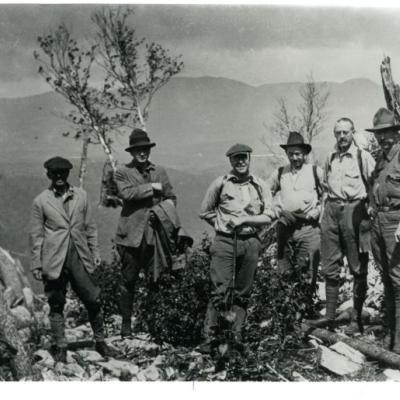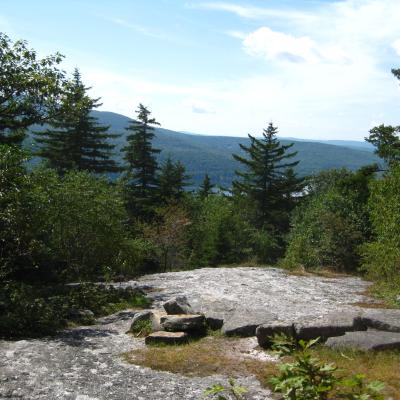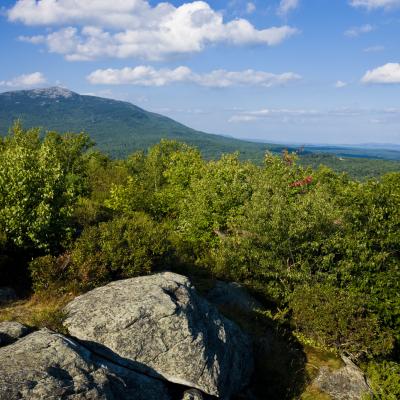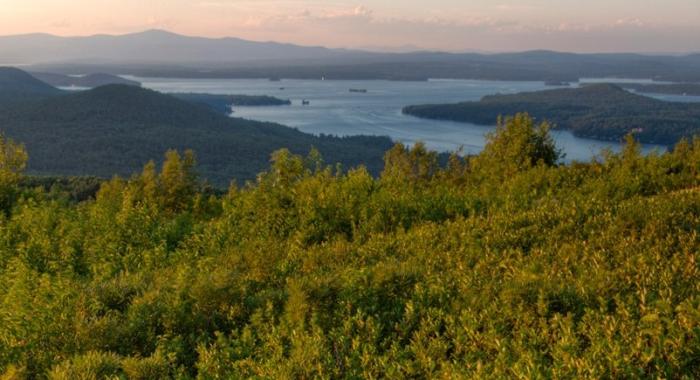Protecting New Hampshire's most important landscapes since 1901

1901
- Eight concerned citizens form the Society for the Protection of New Hampshire Forests. Their mission: to protect the White Mountains, which are rapidly being clear-cut.
1904
- Mission Statement adopted: "The Society is a forestry association seeking to perpetuate the forests of New Hampshire through their wise use and their complete reservation in places of special scenic beauty."
1908
- The Forest Society urges the state of New Hampshire to buy Crawford Notch. It does three years later.
1909
- As a result of Forest Society urging, the state of New Hampshire appoints a state forester, and passes its first forest fire prevention laws.
1911
- The Weeks Act is passed by Congress, after intense lobbying by the Forest Society and other conservation groups, leading to the establishment of the White Mountain National Forest.
- The Forest Society buys 656 acres on Mount Sunapee to save it from being clear-cut.
1912
- The Forest Society buys 148 acres around Lost River Gorge.
1915
- The Forest Society acquires title to 600 acres on Mount Monadnock, beginning a process that ends up protecting more than 4,000 acres on the landmark mountain.
1918
- The Forest Society begins work to acquire 1,500 acres on Mount Kearsarge.
1920
- The Forest Society releases two breeding pairs of Minnesota beavers at Lost River. Prior to this, beaver had been extinct in New Hampshire for 30 years.
1923
- The Forest Society leads a campaign to purchase 6,000 acres in Franconia Notch, including the Old Man of the Mountain, the Flume, the Basin, and two mountain lakes.

1927
- The Forest Society helps the state to buy Franconia Notch. The Forest Society retains ownership of 913 acres, including the Flume, and runs the park for 20 years until 1947.
1932
- The Forest Society opens its first annual Nature Camp at Lost River. More than a century later, the Forest Society is still teaching people about the wonders of forests.
1934
- The Forest Society helps defeat a proposal to build a "skyline drive" across the Presidential Range.
1937
- The Forest Society begins publication of its magazine, Forest Notes, which is still published today.
1943
- The Forest Society helps protect land surrounding Echo Lake and White Horse Ledge in North Conway.
1942
- The state passes a constitutional amendment to end the annual taxation of growing timber — a victory the Forest Society had fought for since 1901.
1945
- The Forest Society helps form the New England Forestry Foundation to promote better forest practices.
1948
- The Forest Society transfers its 1,116 acres on Mount Sunapee to the state of New Hampshire.
1949
- The Forest Society brings the Tree Farm program to the state, which encourages landowners to manage their woodlands for the long term.
1950
- The Forest Society gives its final 520 acres on Mount Kearsarge to the state for the Frank Rollins Memorial Park, honoring the Forest Society's first president.
1959
- The Forest Society opposes a super highway through Franconia Notch.
1960
- Mr. & Mrs. Clarence L. Hay give the Forest Society 675 acres of woodland on Lake Sunapee.

1962
- The Forest Society stops a plan to floodlight the Old Man of the Mountains.
- Working with the Audubon Society of New Hampshire, and the state Fish & Game department, the Forest Society purchases land in the Hampton Salt Marshes to thwart a major development project.
1963
- The Forest Society leads the way on legislation that creates town conservation commissions.
1966
- Thirty-eight towns now have conservation commissions (by 2014 there will be 216 commissions).
1969
- Plans for a nuclear power plant at Seabrook spur the Forest Society to lobby for extensive review of all major power installations.
1970
- The federal government withdraws its plans for a tunnel and four-lane highway through Franconia Notch.
- The Forest Society forms an interstate coalition to fight a proposed east-west superhighway across Vermont, New Hampshire and Maine.
- The Forest Society opens an EcoCenter at Mount Monadnock to teach the 75,000 annual visitors about the mountain's ecology.
1971
- The Forest Society negotiates its first conservation easement, which allows landowners to keep their land while preventing future development.
1972
- The Forest Society begins a campaign to protect Sandwich Notch — the last unprotected notch in the state.
1973
- After years of debate, the legislature enacts Current Use taxation, allowing millions of acres of land to remain as open space. A plan for a smaller parkway through Franconia Notch wins Forest Society support.
1974
- The Forest Society purchases 726 acres on Gap Mountain. The next year, Mrs. Francis Fiske donates the south peak to the organization.
- The Forest Society owns 7,189 acres in the state.

1976
- The Forest Society celebrates the re-opening of the Monadnock-Sunapee Greenway, first laid out by Forest Society President Phil Ayres in 1925.
1978
- Groundbreaking for the Forest Society's new headquarters begins. The award-winning Conservation Center gets over 80% of its heat from the sun and is an appropriate symbol of the organization's commitment to renewable resource use.
1982
- The Forest Society works to get a bottle bill passed in the state, but it fails by one vote.
1983
- The Forest Society helps raise awareness about the impacts of acid rain on New England's forests, laying the groundwork for important amendments to the Clean Air Act.
1984
- The Wilderness Act passes the US Congress, designating 77,000 acres in the White Mountain National Forest as wilderness. Forest Society President Paul Bofinger chaired the committee that reached consensus on the bill.
- The Forest Society owns 16,184 acres in the state.
1986
- The Forest Society starts the Trust for New Hampshire Lands/Land Conservation Investment Program, a public-private six-year partnership that would protect more than 100,000 new acres in the state.
1987
- A 10-year management plan is approved for the White Mountain National Forest. The Forest Society played a lead role in helping finalize the plan.
1989
- The Forest Society, the state, The Nature Conservancy, and the U.S. Forest Service help save 40,000-acre Nash Stream forest in northern New Hampshire.
1990
- The Forest Society serves on the Northern Forest Lands Council to find ways to sustain the four-state, 26-million acre forest and its people.
1993
- The Forest Society creates the New Hampshire Conservation Institute to enhance and streamline its education and research efforts.
- The Forest Society produces its award-winning Guide to Logging Aesthetics and a companion video to promote low-impact forestry without high impact costs.
1994
- Forest Society reservations add up to 24,584 acres.
1995
- The Forest Society creates its Living Landscape Agenda, a two-pronged plan to save special places and take care of land into the next century.
1997
- The Forest Society acquires its 100th reservation - the High Watch Preserve in Effingham and Freedom.
1999
- The Forest Society becomes the first private landowner in New Hampshire to have its land green-certified by SmartWood.
2001
- The Forest Society celebrates its 100th anniversary — a century of outstanding accomplishments in the conservation and reservation of New Hampshire's forests.
2002
- The Forest Society and the Museum of New Hampshire History launch a joint-project entitled Claiming the Land: Our Past, Our Future, Our Choice.
- The New Hampshire House and Senate pass legislation regarding all-terrain vehicles (ATVs). The bill sets a policy for new ATV trails on state land and increases registration fees with revenue directed to enforcement, education, and trail acquisition. The Forest Society lent strong support to this bill.
- The Forest Society, New Hampshire Public Television, and Cross Current Productions collaborate to produce Livable Landscapes: Chance or Choice , a one-hour documentary about citizens combating sprawl in their communities.
2003
- The French Wing addition to the Forest Society's Conservation Center earns national recognition for innovation in "green building" design and construction. The U.S. Green Building Council awards its gold certification to the organization under the rigorous standards of the Leadership in Energy and Environmental Design program.
- The Forest Society, federal and state officials, and other partner conservation organizations celebrate the permanent protection of 171,000 acres in northern New Hampshire.
- The Connecticut Headwaters Project is the largest contiguous block of New Hampshire land in private ownership, comprising roughly three percent of the state.
2007
- The Forest Society protects 3892 acres in fiscal year 2007, including 845 acres (10 projects) in forest reservations (land we own, 2,995 acres (27 projects) on which we hold conservation easements, and 52 acres (two projects) that we protected and will be transferred to a third party.
- The Forest Society is also pleased to announce permanent LCHIP funding. The New Hampshire Land and Community Heritage Investment Program (LCHIP) is an independent state authority that makes grants to New Hampshire communities and non-profits to conserve and preserve New Hampshire’s most important natural, cultural and historic resources. Through this grant program every dollar invested brings in significant local, private, federal funds, and helps New Hampshire businesses and traditional business districts.
2013
- The Forest Society is accredited by the Land Trust Alliance Accreditation Commission. The Commission, established in 2006 as an independent program of the Land Trust Alliance in Washington, DC, conducts an extensive review of each applicant’s policies and programs to determine if the applicant meets the national standards for excellence, upholds the public trust and ensures that conservation efforts are permanent.
2019
- On February 13, 2019, a fire at The Rocks destroyed two historic buildings that we used for office space, programming, a gift shop and farm operations. In the wake of this devastating loss, the Forest Society had an opportunity to rethink the vision for this iconic North Country destination and launched a restoration project in 2020.
- After nine years of hearings, meetings, and strategy sessions, the NH Supreme Court dealt a death blow to the Northern Pass project by ruling that the Site Evaluation Committee had indeed followed appropriate legal protocol in denying Northern Pass a certificate of site and facility. It was big win for New Hampshire’s landscapes, forests, and communities. Once again New Hampshire citizens stood their ground for the things they hold dear: open spaces unmarred by commercial development, downtowns with scenic charm, communities with a sense of who they are and what they want to be, farms that provide livelihoods for families, and the overwhelming sense that New Hampshire citizens, not some company from away, have the right—even an obligation—to determine their future.
2020
- The Forest Society protected the Ammonoosuc River Forest in Bethlehem as its 191st forest reservation.
2022
- Renovations begin at the Carriage Barn at The Rocks. It will retain its grand stone and shingle-style character while the interior is converted into an energy-efficient education center, with classrooms, event space, offices, and public facilities.

Join The Forest Society
Our 10,000 members make us what we are today – one of the most effective statewide land conservation organizations in the country. Through years of member support, the Society for the Protection of New Hampshire Forests has helped to protect open space in communities across the state, including some of the most stunning landscapes, important wildlife habitat and popular outdoor recreation destinations in the Northeast.
